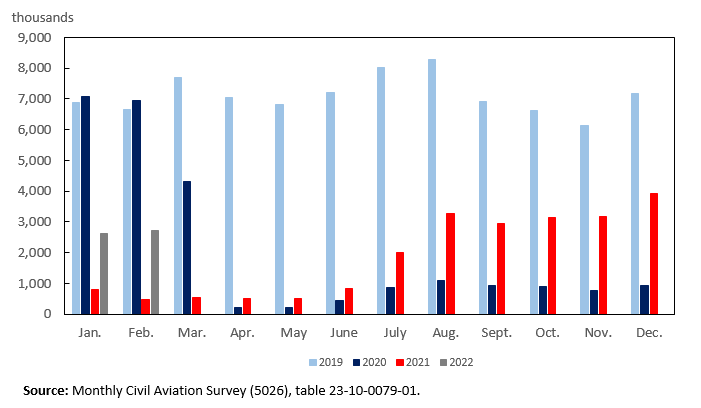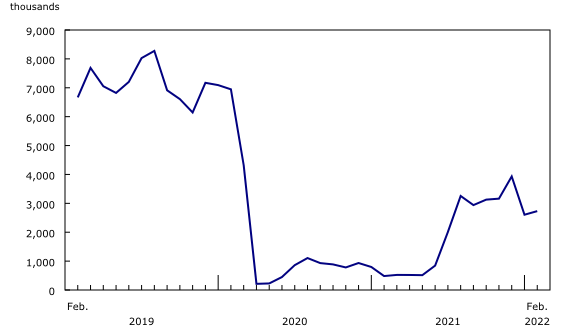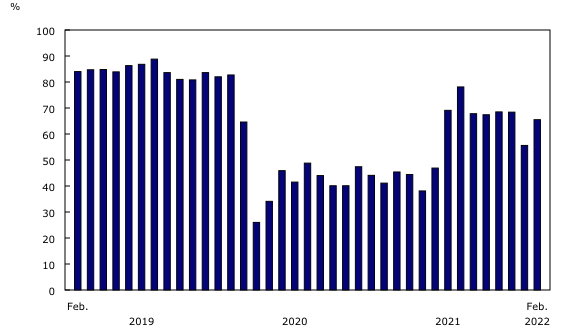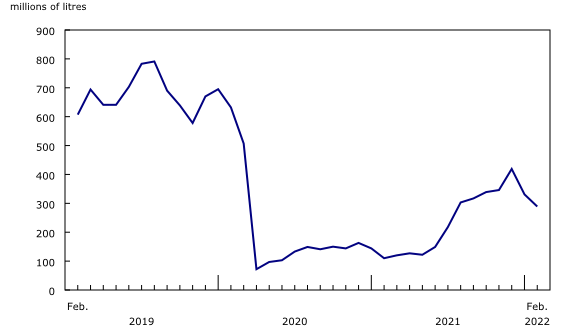Monthly civil aviation statistics, February 2022
Released: 2022-04-28
Highlights
Major Canadian airlines carried 2.7 million passengers on scheduled and charter services in February. While this was more than five times the number of passengers carried in February 2021, it was 40.9% of the level reported in February 2019, prior to the COVID-19 pandemic.
With traffic at 6.7 billion passenger-kilometres and capacity at 10.2 billion available seat-kilometres, the passenger load factor (the ratio of passenger-kilometres to available seat-kilometres) was 65.5% in February.
The $879.9 million operating revenue earned was nearly half (49.4%) of that earned before the pandemic in February 2019.
Schedules remain reduced
Reduced schedules and flight cancellations due to the Omicron variant of COVID-19 continued to affect air travel in February. The advisory against non-essential international travel remained in effect, as did the PCR testing requirement. On February 15, it was announced that these would be lifted on February 28, and authorized antigen tests will become acceptable as the pre-departure testing method.
On March 11, 2020, COVID-19 was declared a pandemic by the World Health Organization. In the months that followed, Canadian air travel remained well below historical levels. Unless otherwise specified, comparisons for a given month are made with the same month in 2019 (also referred to as "pre-pandemic levels"), when airline activity levels were in line with historical trends.
Slight improvement in February
Canadian Level I air carriers flew 2.7 million passengers on scheduled and charter services in February, which was 40.9% of the pre-pandemic level reported in February 2019. Although an improvement over the 37.9% proportion recorded in January 2022 (compared with January 2019), this was below the proportions reached during the final four months of 2021 (compared with the corresponding months of 2019).
On a monthly basis, the number of passengers on both domestic and international flights increased in February from the January dip caused by the Omicron variant. Typically, passenger volumes are lower in February, which is the shortest month of the year.
In February, passenger-kilometres increased while capacity decreased from January as airlines adjusted their schedules. With traffic at 6.7 billion passenger-kilometres and capacity at 10.2 billion available seat-kilometres, the passenger load factor was 65.5% in February, up from 55.6% in January. While returning closer to the values reached in the second half of 2021, it remains well below the February 2019 load factor of 84.0%.
Each passenger travelled an average of 2,456 kilometres in February, down 4.8% from February 2019.
At 90,000, the number of flying hours in February was 49.5% of the pre-pandemic level.
Operating revenue earned by Level I carriers totalled $879.9 million in February, representing 49.4% of the $1.8 billion earned in the same month in 2019, pre-pandemic.
Note to readers
The Monthly Civil Aviation Survey covers all Canadian Level I air carriers: Air Canada (including Air Canada Rouge), Air Transat, Jazz, Porter, Sunwing and WestJet (including Swoop, WestJet Encore and WestJet Link).
The average passenger trip length is calculated by dividing the number of passenger-kilometres by the number of passengers. Trips across Canada and around the world are included in this calculation.
The data in this monthly release are not seasonally adjusted.
Data for the previous four months have been revised.
Contact information
For more information, or to enquire about the concepts, methods or data quality of this release, contact us (toll-free 1-800-263-1136; 514-283-8300; infostats@statcan.gc.ca) or Media Relations (statcan.mediahotline-ligneinfomedias.statcan@statcan.gc.ca).
- Date modified:





